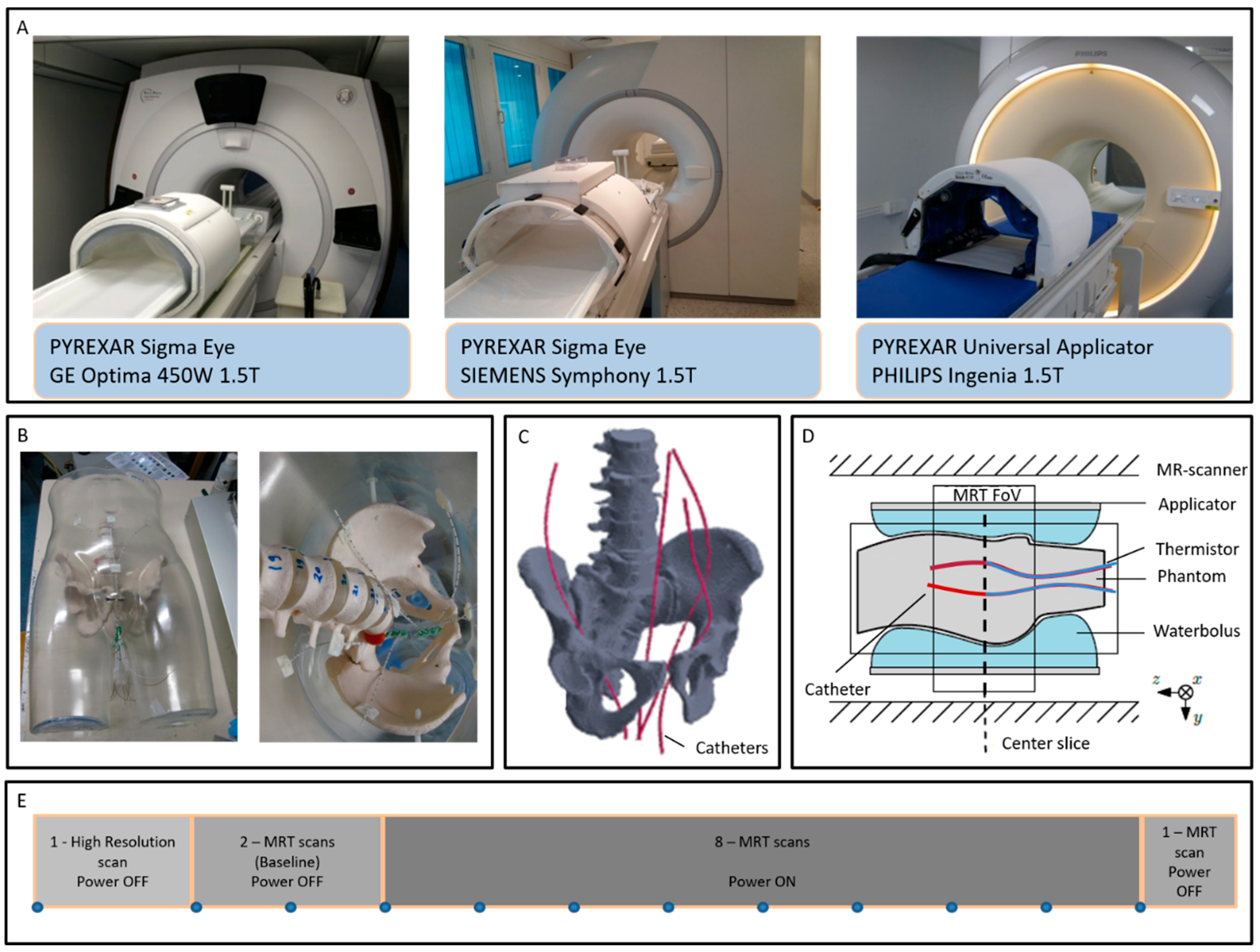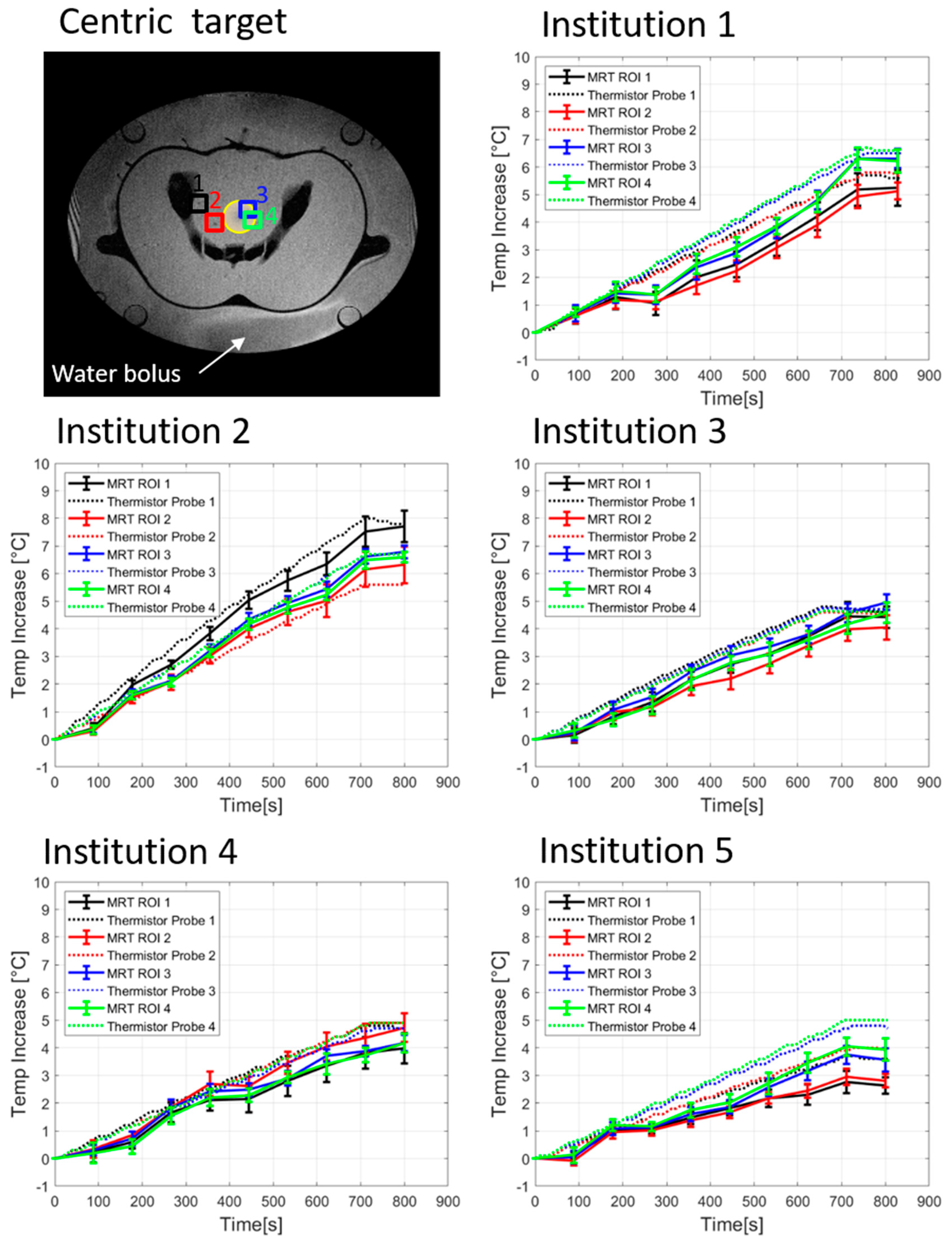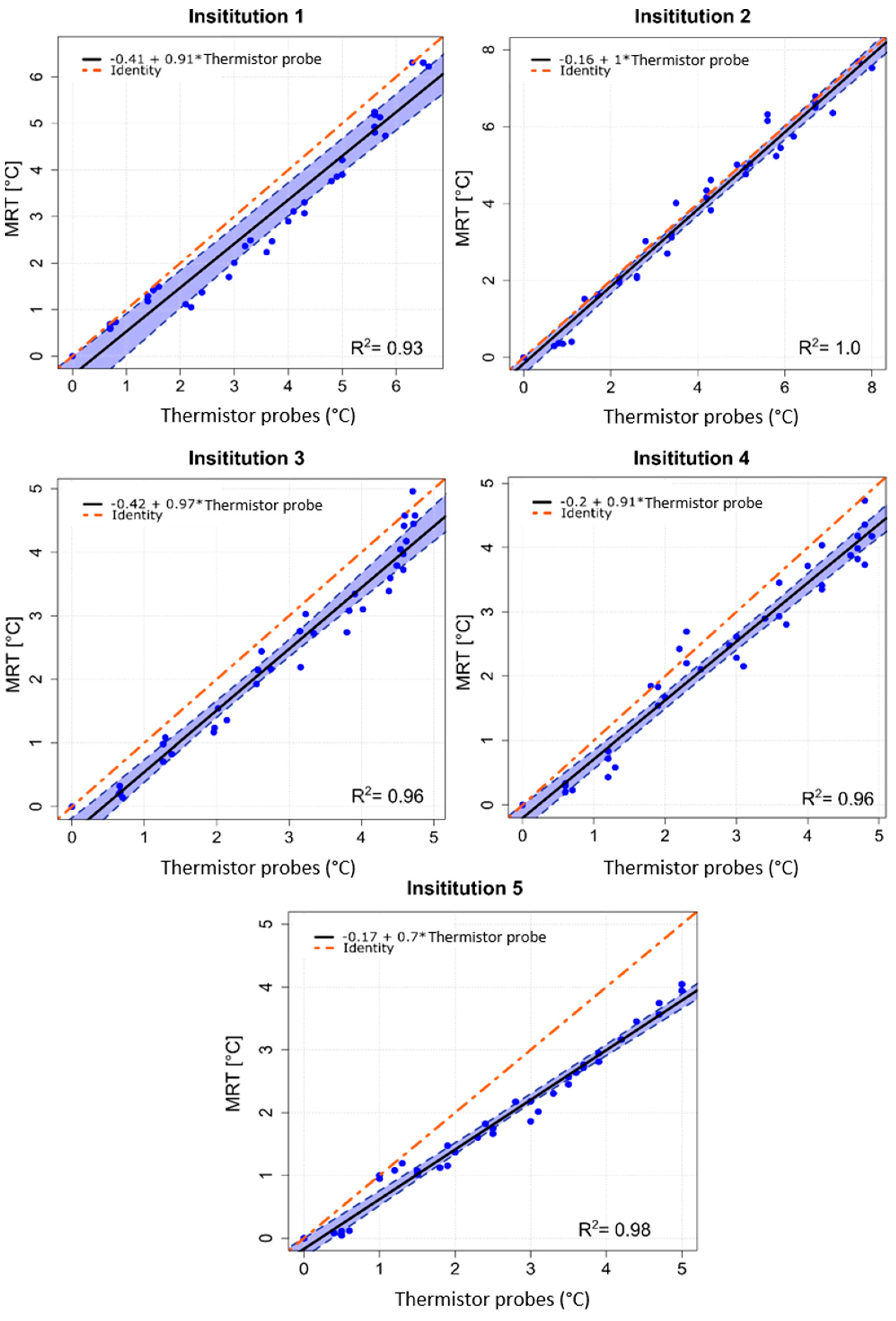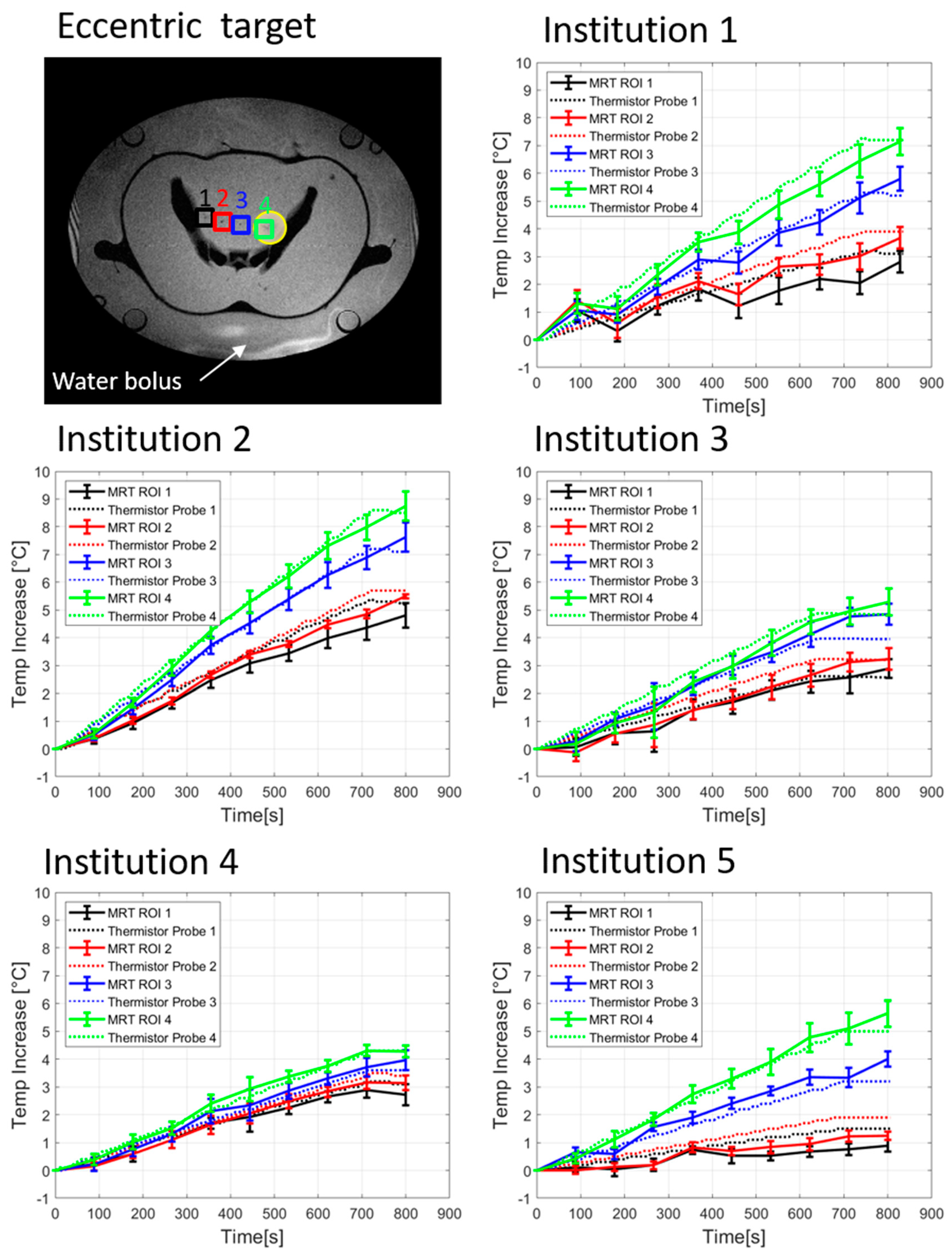Quantitative, Multi-institutional Evaluation of MR Thermometry Accuracy for Deep-Pelvic MR-Hyperthermia Systems Operating in Multi-vendor MR-systems Using a New Anthropomorphic Phantom
Abstract
:1. Introduction
2. Methods and Materials
2.1. Phantom Development
2.2. QA Measurements
2.3. Data Analysis
3. Results
3.1. Influence of Cable Length
3.2. MRT vs. Thermistor Probe Measurements Evaluation
3.2.1. Centric Heating Target
3.2.2. Eccentric Heating Target
4. Discussion
5. Conclusions
Author Contributions
Funding
Conflicts of Interest
References
- Van der Zee, J. Heating the patient: A promising approach? Ann. Oncol. 2002, 13, 1173–1184. [Google Scholar] [CrossRef] [PubMed]
- Datta, N.R.; Rogers, S.; Klingbiel, D.; Gómez, S.; Puric, E.; Bodis, S. Hyperthermia and radiotherapy with or without chemotherapy in locally advanced cervical cancer: A systematic review with conventional and network meta-analyses. Int. J. Hyperth. 2016, 32, 809–821. [Google Scholar] [CrossRef] [PubMed]
- Schooneveldt, G.; Dobšíček Trefná, H.; Persson, M.; de Reijke, T.M.; Blomgren, K.; Kok, H.P.; Crezee, H. Hyperthermia treatment planning including convective flow in cerebrospinal fluid for brain tumour hyperthermia treatment using a novel dedicated paediatric brain applicator. Cancers 2019, 11, 1183. [Google Scholar] [CrossRef] [PubMed]
- Franckena, M.; Fatehi, D.; de Bruijne, M.; Canters, R.A.M.; van Norden, Y.; Mens, J.W.; van Rhoon, G.C.; van der Zee, J. Hyperthermia dose-effect relationship in 420 patients with cervical cancer treated with combined radiotherapy and hyperthermia. Eur. J. Cancer 2009, 45, 1969–1978. [Google Scholar] [CrossRef] [PubMed]
- Jones, E.L. Randomized trial of hyperthermia and radiation for superficial tumors. J. Clin. Oncol. 2005, 23, 3079–3085. [Google Scholar] [CrossRef]
- Thrall, D.E. Thermal dose is related to duration of local control in canine sarcomas treated with thermoradiotherapy. Clin. Cancer Res. 2005, 11, 5206–5214. [Google Scholar] [CrossRef]
- Kroesen, M.; Mulder, H.T.; Van Holthe, N.; Aangeenbrug, A.A.; Mens, J.W.M.; van Doorn, H.C.; Paulides, M.M.; Oomen-de Hoop, E.; Vernhout, R.M.; Lutgens, L.C.; et al. Confirmation of thermal dose as a predictor of local control in cervical carcinoma patients treated with state-of-the-art radiation therapy and hyperthermia. Submitt. Radiother. Oncol. 2019, 140, 150–158. [Google Scholar] [CrossRef]
- Sneed, P.K.; Stauffer, P.R.; McDermott, M.W.; Diederich, C.J.; Lamborn, K.R.; Prados, M.D.; Chang, S.; Weaver, K.A.; Spry, L.; Malec, M.K.; et al. Survival benefit of hyperthermia in a prospective randomized trial of brachytherapy boost ± hyperthermia for glioblastoma multiforme. Int. J. Radiat. Oncol. 1998, 40, 287–295. [Google Scholar] [CrossRef]
- Issels, R.D.; Lindner, L.H.; Verweij, J.; Wessalowski, R.; Reichardt, P.; Wust, P.; Ghadjar, P.; Hohenberger, P.; Angele, M.; Salat, C.; et al. Effect of neoadjuvant chemotherapy plus regional hyperthermia on long-term outcomes among patients with localized high-risk soft tissue sarcoma: The EORTC 62961-ESHO 95 randomized clinical trial. JAMA Oncol. 2018, 4, 483–492. [Google Scholar] [CrossRef]
- Mulder, H.T.; Curto, S.; Paulides, M.M.; Franckena, M.; van Rhoon, G.C. Systematic quality assurance of the BSD2000-3D MR-compatible hyperthermia applicator performance using MR temperature imaging. Int. J. Hyperth. 2018, 35, 305–313. [Google Scholar] [CrossRef] [Green Version]
- Gellermann, J.; Wlodarczyk, W.; Ganter, H.; Nadobny, J.; Fähling, H.; Seebass, M.; Felix, R.; Wust, P. A practical approach to thermography in a hyperthermia/magnetic resonance hybrid system: Validation in a heterogeneous phantom. Int. J. Radiat. Oncol. 2005, 61, 267–277. [Google Scholar] [CrossRef] [PubMed]
- Dobšíček Trefná, H.; Schmidt, M.; van Rhoon, G.C.; Kok, H.P.; Gordeyev, S.S.; Lamprecht, U.; Marder, D.; Nadobny, J.; Ghadjar, P.; Abdel-Rahman, S.; et al. Quality assurance guidelines for interstitial hyperthermia. Int. J. Hyperth. 2019, 36, 277–294. [Google Scholar] [CrossRef] [PubMed]
- Dobšíček Trefná, H.; Crezee, J.; Schmidt, M.; Marder, D.; Lamprecht, U.; Ehmann, M.; Nadobny, J.; Hartmann, J.; Lomax, N.; Abdel-Rahman, S.; et al. Quality assurance guidelines for superficial hyperthermia clinical trials: II. Technical requirements for heating devices. Strahlenther. Onkol. 2017, 193, 351–366. [Google Scholar] [CrossRef] [PubMed]
- Bruggmoser, G.; Bauchowitz, S.; Canters, R.; Crezee, H.; Ehmann, M.; Gellermann, J.; Lamprecht, U.; Lomax, N.; Messmer, M.B.; Ott, O.; et al. Guideline for the clinical application, documentation and analysis of clinical studies for regional deep hyperthermia: Quality management in regional deep hyperthermia. Strahlenther. Onkol. 2012, 188, 198–211. [Google Scholar] [CrossRef] [PubMed]
- Aklan, B.; Zilles, B.; Paprottka, P.; Manz, K.; Pfirrmann, M.; Santl, M.; Abdel-Rahman, S.; Lindner, L.H. Regional deep hyperthermia: Quantitative evaluation of predicted and direct measured temperature distributions in patients with high-risk extremity soft-tissue sarcoma. Int. J. Hyperth. 2019, 36, 170–185. [Google Scholar] [CrossRef]
- Kok, H.P.; Wust, P.; Stauffer, P.R.; Bardati, F.; Van Rhoon, G.C.; Crezee, J. Current state of the art of regional hyperthermia treatment planning: A review. Radiat. Oncol. 2015, 10, 196. [Google Scholar] [CrossRef]
- Van der Zee, J.; Peervalstar, J.; Rietveld, P.; Degraafstrukowska, L.; Van Rhoon, G.C. Practical limitations of interstitial thermometry during deep hyperthermia. Int. J. Radiat. Oncol. 1998, 40, 1205–1212. [Google Scholar] [CrossRef]
- Jones, E.; Alvarez Secord, A.; Prosnitz, L.R.; Samulski, T.V.; Oleson, J.R.; Berchuck, A.; Clarke-Pearson, D.; Soper, J.; Dewhirst, M.W.; Vujaskovic, Z. Intra-peritoneal cisplatin and whole abdomen hyperthermia for relapsed ovarian carcinoma. Int. J. Hyperth. 2006, 22, 161–172. [Google Scholar] [CrossRef]
- Carter, D.L.; MacFall, J.R.; Clegg, S.T.; Wan, X.; Prescott, D.M.; Charles, H.C.; Samulski, T.V. Magnetic resonance thermometry during hyperthermia for human high-grade sarcoma. Int. J. Radiat. Oncol. 1998, 40, 815–822. [Google Scholar] [CrossRef]
- Wust, P.; Hildebrandt, B.; Sreenivasa, G.; Rau, B.; Gellermann, J.; Riess, H.; Felix, R.; Schlag, P.M. Hyperthermia in combined treatment of cancer. Lancet Oncol. 2002, 3, 487–497. [Google Scholar] [CrossRef]
- Peller, M.; Reinl, H.M.; Weigel, A.; Meininger, M.; Issels, R.D.; Reiser, M. T1 relaxation time at 0.2 Tesla for monitoring regional hyperthermia: Feasibility study in muscle and adipose tissue. Magn. Reson. Med. 2002, 47, 1194–1201. [Google Scholar] [CrossRef] [PubMed]
- Numan, W.C.M.; Hofstetter, L.W.; Kotek, G.; Bakker, J.F.; Fiveland, E.W.; Houston, G.C.; Kudielka, G.; Yeo, D.T.B.; Paulides, M.M. Exploration of MR-guided head and neck hyperthermia by phantom testing of a modified prototype applicator for use with proton resonance frequency shift thermometry. Int. J. Hyperth. 2014, 30, 184–191. [Google Scholar] [CrossRef] [PubMed]
- Oberacker, E.; Kuehne, A.; Nadobny, J.; Zschaeck, S.; Weihrauch, M.; Waiczies, H.; Ghadjar, P.; Wust, P.; Niendorf, T.; Winter, L. Radiofrequency applicator concepts for simultaneous MR imaging and hyperthermia treatment of glioblastoma multiforme. Curr. Dir. Biomed. Eng. 2017, 3, 473–477. [Google Scholar] [CrossRef] [Green Version]
- Gellermann, J.; Wlodarczyk, W.; Feussner, A.; Fähling, H.; Nadobny, J.; Hildebrandt, B.; Felix, R.; Wust, P. Methods and potentials of magnetic resonance imaging for monitoring radiofrequency hyperthermia in a hybrid system. Int. J. Hyperth. 2005, 21, 497–513. [Google Scholar] [CrossRef]
- Tarasek, M.R.; Pellicer, R.; Hofstetter, L.W.; Numan, W.C.M.; Bakker, J.F.; Kotek, G.; Togni, P.; Verhaart, R.F.; Fiveland, E.W.; Houston, G.C.; et al. Validation of MR thermometry: Method for temperature probe sensor registration accuracy in head and neck phantoms. Int. J. Hyperth. 2014, 30, 142–149. [Google Scholar] [CrossRef]
- Gellermann, J.; Wlodarczyk, W.; Hildebrandt, B.; Ganter, H.; Nicolau, A.; Rau, B.; Tilly, W.; Fähling, H.; Nadobny, J.; Felix, R.; et al. Noninvasive magnetic resonance thermography of recurrent rectal carcinoma in a 1.5 Tesla hybrid system. Cancer Res. 2005, 65, 5872–5880. [Google Scholar] [CrossRef]
- Gellermann, J.; Hildebrandt, B.; Issels, R.; Ganter, H.; Wlodarczyk, W.; Budach, V.; Felix, R.; Tunn, P.-U.; Reichardt, P.; Wust, P. Noninvasive magnetic resonance thermography of soft tissue sarcomas during regional hyperthermia: Correlation with response and direct thermometry. Cancer 2006, 107, 1373–1382. [Google Scholar] [CrossRef]
- Craciunescu, O.I.; Stauffer, P.R.; Soher, B.J.; Wyatt, C.R.; Arabe, O.; Maccarini, P.; Das, S.K.; Cheng, K.-S.; Wong, T.Z.; Jones, E.L.; et al. Accuracy of real time noninvasive temperature measurements using magnetic resonance thermal imaging in patients treated for high grade extremity soft tissue sarcomas: Noninvasive temperature monitoring using magnetic resonance thermal imaging. Med. Phys. 2009, 36, 4848–4858. [Google Scholar] [CrossRef]
- Poorter, J.D. Noninvasive MRI thermometry with the proton resonance frequency method: Study of susceptibility effects. Magn. Reson. Med. 1995, 34, 359–367. [Google Scholar] [CrossRef]
- Poorter, J.D.; Wagter, C.D.; Deene, Y.D.; Thomsen, C.; Ståhlberg, F.; Achten, E. Noninvasive MRI thermometry with the proton resonance frequency (PRF) method: In vivo results in human muscle. Magn. Reson. Med. 1995, 33, 74–81. [Google Scholar] [CrossRef]
- Rieke, V.; Butts Pauly, K. MR thermometry. J. Magn. Reson. Imaging 2008, 27, 376–390. [Google Scholar] [CrossRef] [PubMed]
- Winter, L.; Oberacker, E.; Paul, K.; Ji, Y.; Oezerdem, C.; Ghadjar, P.; Thieme, A.; Budach, V.; Wust, P.; Niendorf, T. Magnetic resonance thermometry: Methodology, pitfalls and practical solutions. Int. J. Hyperth. 2016, 32, 63–75. [Google Scholar] [CrossRef] [PubMed]
- Giavarina, D. Understanding Bland Altman analysis. Biochem. Med. 2015, 25, 141–151. [Google Scholar] [CrossRef] [PubMed] [Green Version]
- Udovicic, M.; Bazdaric, K.; Bilic-Zulle, L.; Petrovecki, M. What we need to know when calculating the coefficient of correlation? Biochem. Med. 2007, 17, 10–15. [Google Scholar] [CrossRef]
- Paulides, M.M.; Mestrom, R.M.C.; Salim, G.; Adela, B.B.; Numan, W.C.M.; Drizdal, T.; Yeo, D.T.B.; Smolders, A.B. A printed Yagi–Uda antenna for application in magnetic resonance thermometry guided microwave hyperthermia applicators. Phys. Med. Biol. 2017, 62, 1831–1847. [Google Scholar] [CrossRef]
- Altman, D.G.; Bland, J.M. Measurement in medicine: The analysis of method comparison studies. Statistician 1983, 32, 307–317. [Google Scholar] [CrossRef]
- Dadakova, T.; Gellermann, J.; Voigt, O.; Korvink, J.G.; Pavlina, J.M.; Hennig, J.; Bock, M. Fast PRF-based MR thermometry using double-echo EPI: In vivo comparison in a clinical hyperthermia setting. Magn. Reson. Mater. Phys. 2015, 28, 305–314. [Google Scholar] [CrossRef]
- Gellermann, J.; Weihrauch, M.; Cho, C.H.; Wlodarczyk, W.; Fähling, H.; Felix, R.; Budach, V.; Weiser, M.; Nadobny, J.; Wust, P. Comparison of MR-thermography and planning calculations in phantoms: MR-thermography versus planning. Med. Phys. 2006, 33, 3912–3920. [Google Scholar] [CrossRef]
- Weihrauch, M.; Wust, P.; Weiser, M.; Nadobny, J.; Eisenhardt, S.; Budach, V.; Gellermann, J. Adaptation of antenna profiles for control of MR guided hyperthermia (HT) in a hybrid MR-HT system. Med. Phys. 2007, 34, 4717–4725. [Google Scholar] [CrossRef]
- Wlodarczyk, W.; Boroschewski, R.; Hentschel, M.; Wust, P.; Mönich, G.; Felix, R. Three-dimensional monitoring of small temperature changes for therapeutic hyperthermia using MR. J. Magn. Reson. Imaging 1998, 8, 165–174. [Google Scholar] [CrossRef]







| Institution | Scan Type | TR (ms) | TE1 (ms) | TE2 (ms) | FA (deg) | Acquisition Matrix | Reconstruction Matrix | Scan Time (sec) |
|---|---|---|---|---|---|---|---|---|
| 1 | High Resolution | 120 | 4.8 | 9.60 | 70 | 256/256 | 256/256 | 136 |
| MRT | 620 | 4.8 | 19.1 | 40 | 128/128 | 256/256 | 83 | |
| 2 4 5 | High Resolution | 120 | 4.76 | 9.53 | 70 | 256/256 | 256/256 | 124 |
| MRT | 600 | 4.76 | 19.10 | 50 | 128/128 | 128/128 | 78 | |
| 3 | High Resolution | 120 | 4.60 | 9.21 | 70 | 252/250 | 256/256 | 151 |
| MRT | 600 | 4.60 | 18.42 | 50 | 128/128 | 256/256 | 79 |
| Institution | Temperature Measurement | Mean Temperature Increase [ΔT (°C)] at Locations 1 to 4 | Mean Temperature Increase± SD (°C) | |||
|---|---|---|---|---|---|---|
| ΔT Location 1 | ΔT Location 2 | ΔT Location 3 | ΔT Location 4 | |||
| 1 | Thermistor probe | 4.7 | 4.6 | 5.2 | 5.3 | 5.0 ± 0.3 |
| MRT | 3.8 | 3.5 | 4.3 | 4.3 | 4.0 ± 0.3 | |
| 2 | Thermistor probe | 6.8 | 4.7 | 5.6 | 5.6 | 5.7 ± 0.7 |
| MRT | 6.2 | 4.9 | 5.3 | 5.1 | 5.4 ± 0.5 | |
| 3 | Thermistor probe | 4.4 | 4.2 | 4.4 | 4.3 | 4.3 ± 0.1 |
| MRT | 3.6 | 3.2 | 3.7 | 3.5 | 3.5 ± 0.2 | |
| 4 | Thermistor probe | 4.1 | 4.1 | 3.9 | 4.0 | 4.0 ± 0.1 |
| MRT | 3.2 | 3.9 | 3.5 | 3.3 | 3.5 ± 0.3 | |
| 5 | Thermistor probe | 3.2 | 3.4 | 4.0 | 4.2 | 3.7 ± 0.4 |
| MRT | 2.3 | 2.4 | 3.0 | 3.3 | 2.7 ± 0.4 | |
| Institution | Temp. Measurem. | Mean Temperature Increase [ΔT (°C)] at Locations 1 to 4 | Mean Temp. Increase ± SD (°C) | d(ΔT Location 4- ΔT Location 1) (°C) | |||
|---|---|---|---|---|---|---|---|
| ΔT Location 1 | ΔT Location 2 | ΔT Location 3 | ΔT Location 4 | ||||
| 1 | Thermistor probe | 2.6 | 3.2 | 4.3 | 5.9 | 4.0 ± 1.2 | 3.3 |
| MRT | 2.0 | 2.7 | 4.1 | 5.3 | 3.5 ± 1.3 | 3.3 | |
| 2 | Thermistor probe | 4.5 | 4.7 | 6.1 | 7.2 | 5.6 ± 1.1 | 2.7 |
| MRT | 3.8 | 4.3 | 6.0 | 7.0 | 5.3 ± 1.3 | 3.2 | |
| 3 | Thermistor probe | 2.5 | 3.0 | 3.7 | 4.6 | 3.5 ± 0.8 | 2.1 |
| MRT | 2.3 | 2.5 | 3.9 | 4.4 | 3.3 ± 0.9 | 2.0 | |
| 4 | Thermistor probe | 2.7 | 2.9 | 3.0 | 3.6 | 3.0 ± 0.3 | 0.9 |
| MRT | 2.6 | 2.8 | 3.2 | 3.7 | 3.0 ± 0.4 | 1.1 | |
| 5 | Thermistor probe | 1.3 | 1.7 | 2.8 | 4.3 | 2.5 ± 1.2 | 3.0 |
| MRT | 0.6 | 0.9 | 3.2 | 4.6 | 2.3 ± 1.6 | 3.9 | |
© 2019 by the authors. Licensee MDPI, Basel, Switzerland. This article is an open access article distributed under the terms and conditions of the Creative Commons Attribution (CC BY) license (http://creativecommons.org/licenses/by/4.0/).
Share and Cite
Curto, S.; Aklan, B.; Mulder, T.; Mils, O.; Schmidt, M.; Lamprecht, U.; Peller, M.; Wessalowski, R.; Lindner, L.H.; Fietkau, R.; et al. Quantitative, Multi-institutional Evaluation of MR Thermometry Accuracy for Deep-Pelvic MR-Hyperthermia Systems Operating in Multi-vendor MR-systems Using a New Anthropomorphic Phantom. Cancers 2019, 11, 1709. https://doi.org/10.3390/cancers11111709
Curto S, Aklan B, Mulder T, Mils O, Schmidt M, Lamprecht U, Peller M, Wessalowski R, Lindner LH, Fietkau R, et al. Quantitative, Multi-institutional Evaluation of MR Thermometry Accuracy for Deep-Pelvic MR-Hyperthermia Systems Operating in Multi-vendor MR-systems Using a New Anthropomorphic Phantom. Cancers. 2019; 11(11):1709. https://doi.org/10.3390/cancers11111709
Chicago/Turabian StyleCurto, Sergio, Bassim Aklan, Tim Mulder, Oliver Mils, Manfred Schmidt, Ulf Lamprecht, Michael Peller, Ruediger Wessalowski, Lars H. Lindner, Rainer Fietkau, and et al. 2019. "Quantitative, Multi-institutional Evaluation of MR Thermometry Accuracy for Deep-Pelvic MR-Hyperthermia Systems Operating in Multi-vendor MR-systems Using a New Anthropomorphic Phantom" Cancers 11, no. 11: 1709. https://doi.org/10.3390/cancers11111709









